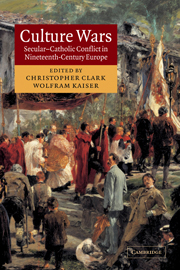Book contents
- Frontmatter
- Contents
- List of illustrations
- List of contributors
- Introduction: The European culture wars
- 1 The New Catholicism and the European culture wars
- 2 ‘Clericalism – that is our enemy!’: European anticlericalism and the culture wars
- 3 ‘Priest hits girl’: on the front line in the ‘war of the two Frances’
- 4 The battle for monasteries, cemeteries and schools: Belgium
- 5 Contested rituals and the battle for public space: the Netherlands
- 6 Nonconformity, clericalism and ‘Englishness’: the United Kingdom
- 7 The assault on the city of the Levites: Spain
- 8 Roma o morte: culture wars in Italy
- 9 Enemies at the gate: the Moabit Klostersturm and the Kulturkampf: Germany
- 10 Village quarrels and national controversies: Switzerland
- 11 The Counter-Reformation's last stand: Austria
- 12 The uncivil origins of civil marriage: Hungary
- Annotated bibliography
- Index
7 - The assault on the city of the Levites: Spain
Published online by Cambridge University Press: 23 July 2009
- Frontmatter
- Contents
- List of illustrations
- List of contributors
- Introduction: The European culture wars
- 1 The New Catholicism and the European culture wars
- 2 ‘Clericalism – that is our enemy!’: European anticlericalism and the culture wars
- 3 ‘Priest hits girl’: on the front line in the ‘war of the two Frances’
- 4 The battle for monasteries, cemeteries and schools: Belgium
- 5 Contested rituals and the battle for public space: the Netherlands
- 6 Nonconformity, clericalism and ‘Englishness’: the United Kingdom
- 7 The assault on the city of the Levites: Spain
- 8 Roma o morte: culture wars in Italy
- 9 Enemies at the gate: the Moabit Klostersturm and the Kulturkampf: Germany
- 10 Village quarrels and national controversies: Switzerland
- 11 The Counter-Reformation's last stand: Austria
- 12 The uncivil origins of civil marriage: Hungary
- Annotated bibliography
- Index
Summary
It is known that the Spanish Catholic church has been one of the most powerful churches of Western Europe over the centuries. Yet, in spite of its strength, liberal revolutions were able to undermine considerably the foundations upon which ecclesiastical power had been built in Spain since the Middle Ages. In the transition from the old to the new regime, the Spanish church suffered severe losses that badly affected its economic, human and pastoral resources, as well as its traditional political and social influence. From 1812 to 1837, constitutional freedoms were proclaimed, the Inquisition was suppressed, the tithe was abolished, the religious orders were disbanded and their properties sold at public auction, the ecclesiastical presence in the fields of charity and education was nearly dismantled, the church was at the mercy of the civil authorities, and in some places – such as Madrid in 1834 or Catalonia in 1835 – at the mercy of angry crowds. To make matters worse for relations between the Catholic church and the liberal state, a great number of clerics embraced the legitimist cause, thus championing the return of absolutist rule, during the first Carlist War (1833–40).
Only very slowly did the Spanish clergy regain their lost positions. Undoubtedly the worst had passed when the Moderates returned to office in 1844 and a Concordat was signed in 1851. The Concordat recognised the Catholic church as the established church and committed the state to financing it.
- Type
- Chapter
- Information
- Culture WarsSecular-Catholic Conflict in Nineteenth-Century Europe, pp. 181 - 201Publisher: Cambridge University PressPrint publication year: 2003
- 4
- Cited by



